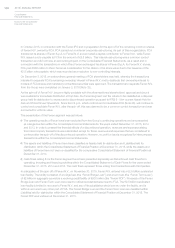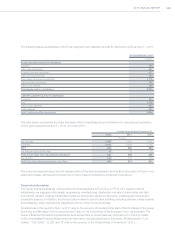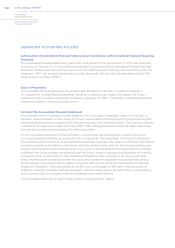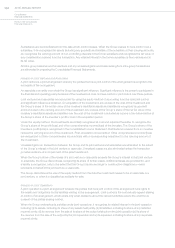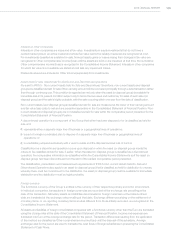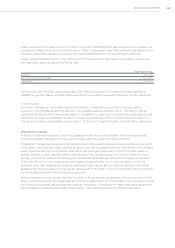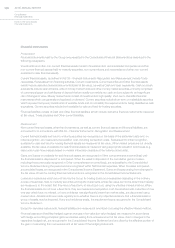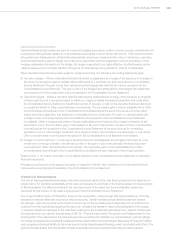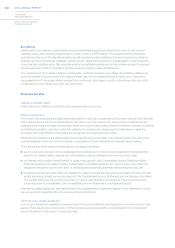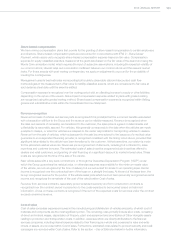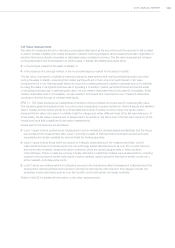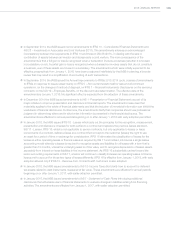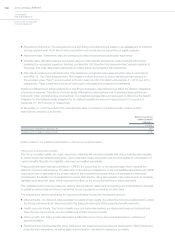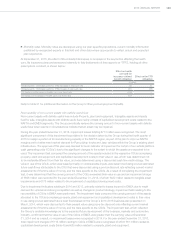Chrysler 2015 Annual Report Download - page 149
Download and view the complete annual report
Please find page 149 of the 2015 Chrysler annual report below. You can navigate through the pages in the report by either clicking on the pages listed below, or by using the keyword search tool below to find specific information within the annual report.
2015 | ANNUAL REPORT 149
Derivative financial instruments
Derivative financial instruments are used for economic hedging purposes in order to reduce currency, interest rate and
market price risks (primarily related to commodities and securities). In accordance with IAS 39 - Financial Instruments:
Recognition and Measurement, all derivative financial instruments are measured at fair value. Furthermore, derivative
financial instruments qualify for hedge accounting only when there is formal designation and documentation of the
hedging relationship at inception of the hedge, the hedge is expected to be highly effective, its effectiveness can be
reliably measured and it is highly effective throughout the financial reporting periods for which it is designated.
When derivative financial instruments qualify for hedge accounting, the following accounting treatments apply:
Fair value hedges – Where a derivative financial instrument is designated as a hedge of the exposure to changes in
fair value of a recognized asset or liability that is attributable to a particular risk and could affect the Consolidated
Income Statement, the gain or loss from remeasuring the hedging instrument at fair value is recognized in the
Consolidated Income Statement. The gain or loss on the hedged item attributable to the hedged risk adjusts the
carrying amount of the hedged item and is recognized in the Consolidated Income Statement.
Cash flow hedges – Where a derivative financial instrument is designated as a hedge of the exposure to variability
in future cash flows of a recognized asset or liability or a highly probable forecasted transaction and could affect
the Consolidated Income Statement, the effective portion of any gain or loss on the derivative financial instrument
is recognized directly in Other comprehensive income/(loss). The cumulative gain or loss is reclassified from Other
comprehensive income/(loss) to the Consolidated Income Statement at the same time as the economic effect
arising from the hedged item that affects the Consolidated Income Statement. The gain or loss associated with
a hedge or part of a hedge that has become ineffective is recognized in the Consolidated Income Statement
immediately. When a hedging instrument or hedge relationship is terminated but the hedged transaction is still
expected to occur, the cumulative gain or loss realized to the point of termination remains in Other comprehensive
income/(loss) and is recognized in the Consolidated Income Statement at the same time as the underlying
transaction occurs. If the hedged transaction is no longer probable, the cumulative unrealized gain or loss held in
Other comprehensive income/(loss) is recognized in the Consolidated Income Statement immediately.
Hedges of a net investment – If a derivative financial instrument is designated as a hedging instrument for a net
investment in a foreign operation, the effective portion of the gain or loss on the derivative financial instrument
is recognized in Other comprehensive income/(loss). The cumulative gain or loss is reclassified from Other
comprehensive income/(loss) to the Consolidated Income Statement upon disposal of the foreign operation.
Refer to Note 17 for further information on the effects reflected in the Consolidated Income Statement on derivative
financial instruments.
If hedge accounting cannot be applied, the gains or losses from the fair value measurement of derivative financial
instruments are recognized immediately in the Consolidated Income Statement.
Transfers of financial assets
The Group derecognizes financial assets when the contractual rights to the cash flows arising from the asset are no
longer held or if it transfers substantially all the risks and rewards of ownership of the financial asset. On derecognition
of financial assets, the difference between the carrying amount of the asset and the consideration received or
receivable for the transfer of the asset is recognized in the Consolidated Income Statement.
The Group transfers certain of its financial, trade and tax receivables, mainly through factoring transactions. Factoring
transactions may be either with recourse or without recourse. Certain transfers include deferred payment clauses
(for example, when the payment by the factor of a minor part of the purchase price is dependent on the total amount
collected from the receivables) requiring first loss cover, whereby the transferor has priority participation in the losses,
or requires a significant exposure to the cash flows arising from the transferred receivables to be retained. These types
of transactions do not meet the requirements of IAS 39 – Financial Instruments: Recognition and Measurement for the
derecognition of the assets since the risks and rewards connected with collection are not transferred, and accordingly
the Group recognizes the receivables transferred by this means within the Consolidated Statement of Financial Position
and recognizes a financial liability for the same amount under Asset-backed financing, which is included within Debt. The
gains and losses arising from the transfer of these receivables are only recognized when they are derecognized.



